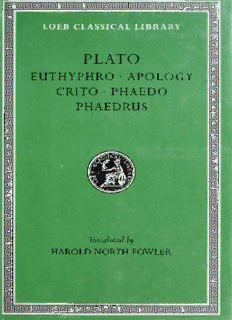
Plato: Euthyphro. Apology. Crito. Phaedo. Phaedrus PDF
Preview Plato: Euthyphro. Apology. Crito. Phaedo. Phaedrus
1 PLATO 1 n EUTHYPHRO APOLOGY i i CRITO PHAEDO PHAEDRUS i i i i i i i i i i i i i Translated by i HAROLD NORTH FOWLER i i i i i i PLATO, the great philosopher of Athens, was born in 427 BC. In early manhood an admirer of Socrates, he later founded the famous school of philosophy in the grove Academus. Much else recorded ofhis life is uncertain; that he left Athens for a time after Socrates' execution is probable; that later he went to Cyrene, Egypt, and Sicily is possible; that he was wealthy is likely; that he was critical of 'advanced' democ- racyisobvious. Helivedtobe 80 yearsold. Linguistic tests including those of com- puterscience stilltryto establishthe order ofhis extantphilosophical dialogues, writ- ten in splendid prose and revealing Socra- tes' mind fused with Plato's thougoht. In Laches, Charmides, and Lysis, Socrates and others discuss separate ethical concep- tions. Protagoras, Ion, and Meno discuss whether rioghteousness can be taugoht. In Gorgias,Socratesisestrangedfromhiscity's thought, and his fate is impending. The Apology (not a dialogue), Crito, Euthyphro, andtheunforgettablePhaedorelatethetrial and death of Socrates and propound the immortalityofthesoul. InthefamousSym- posium and Phaedrus,writtenwhen Socrates wasstillalive,wefindtheoriginandmean- ing of love. Cratylus discusses the nature of language. The great masterpiece in ten books, the Republic, concerns righ- teousness (and involves education, equal- ity of the sexes, the structure of society, and abolition of slavery). Of the six so- calleddialecticaldialoguesEuthydemusdeals with philosophy; metaphysical Parmenides is Continuedon backflap 184 P Plato. Plato / 666584 Vol 1 NYPUBLICLIBRARY.THEBRANCHLIBRARES , 3 3333 20129 5O33 PLATO EUTHYPHRO APOLOGY CRITO PHAEDO PHAEDRUS WITH AN ENGLISH TRANSLATION BY HAROLD NORTH FOWLER INTRODUCTION BY W. R. M. LAMB HARVARD UNIVERSITY PRESS CAMBRIDGE, MASSACHUSETTS LONDON, ENGLAND Firstpublished1914 Reprinted1917, 1919, 1923, 192,5, 192(8', 19.33, I 1942, 1947, 19.53, 1960, 1966, 1971, 1977, 1982, , 1995' *999> 2O05 LOEBCLASSICALLIBRARY isaregisteredtrademark ofthePresidentandFellowsofHarvardCollege ISBN 0-674-99040-4 Printedonacid-freepaperandboundby EdwardsBrothers,AnnArbor,Michigan CONTENTS PREFACE vii INTRODUCTION ix BIBLIOGRAPHY xxi EUTHYPHRO 1 THE APOLOGY 61 CRITO 147 PHAEDO 193 PHAEDRUS 405 INDEX 581 PREFACE THE Greek text in this volume is based upon that of Schanz, and all variations from his readings are noted in the margin at the foot of the page. In some cases deviations from the reading of the manu- scripts have been noted, even when adopted by Schanz. Intheintroductionstotheseparatedialogues no attempt has been made to discuss the philosophy ofPlato or to do anything more than to supply such information as is needed for the intelligent reading ofthese particular dialogues. For further discussion and information the reader is referred tothe General Introduction by Mr. W. R. M. Lamb, of Trinity College, Cambridge. HAROLD N. FOWLER. vn GENERAL INTRODUCTION PLATO was bornin427 B.C. ofAthenianparentswho could provide him with the best education of the day,and ample means and leisurethroughout hislife. He came to manhood in the dismal close of the Peloponnesian War, when Aristophanes was at the height of his success, and Sophocles and Euripides had produced their last plays. As a boyhedoubtless heard the lectures of Gorgias, Protagoras, and other sophists,andhisearlybentseemstohavebeentowards poetry. But his intelligence was too progressive to rest in the agnostic position on which the sophistic culture was based. A century before, Heracleitus had declared knowledge to be impossible, because the objects of sense are continually changing; yet now a certain Cratylus was trying to build a theory ofknowledge over theassertionofflux,bydeveloping some hints let fall by its oracular author about the truth contained in names. From this influencePlato passed into contact with Socrates, whose character and gifts have left a singular impress on the thought of mankind. This effect is almost wholly due to Plato's applications and extensions of his master's ix
Description: